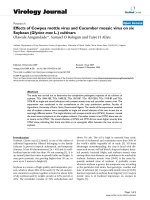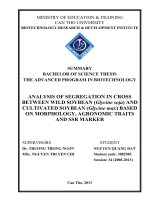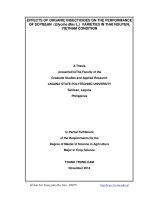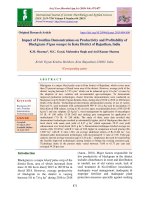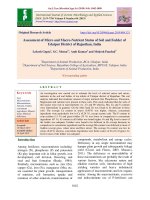Enhancement of soybean (Glycine max L.) productivity and profitability through front line demonstrations in Kota district of Rajasthan, India
Bạn đang xem bản rút gọn của tài liệu. Xem và tải ngay bản đầy đủ của tài liệu tại đây (230.58 KB, 6 trang )
Int.J.Curr.Microbiol.App.Sci (2019) 8(4): 1808-1813
International Journal of Current Microbiology and Applied Sciences
ISSN: 2319-7706 Volume 8 Number 04 (2019)
Journal homepage:
Original Research Article
/>
Enhancement of Soybean (Glycine max L.) Productivity and Profitability
through Front Line Demonstrations in Kota District of Rajasthan, India
K.M. Sharma*, M.C. Goyal, Mahendra Singh and Anil Kumar Sharma
Krishi Vigyan Kendra, Borkhera, Kota (Rajasthan)-324001, India
*Corresponding author
ABSTRACT
Keywords
Soybean, B: C ratio,
Frontline
demonstration,
Technological gap
Article Info
Accepted:
15 March 2019
Available Online:
10 April 2019
Soybean is a major kharif crop of Kota district, which accounts for more than 50 percent
acreage of kharif sown area of the district. Front line demonstrations (FLD’s) on soybean
crop were conducted during kharif seasons of year 2016 to 2018 in 140 ha area on 340
farmer’s fields in 17 different villages of operational area of Krishi Vigyan Kendra, Kota
to demonstrate production potential of improved agro-techniques. Technological
interventions demonstrated consisted of use of variety JS 20-29 & JS 95-60, seed treatment
with carbendazim50 WP @ 2.0 g /kg seed & inoculation of rhizobium & PSB culture,
sowing in 30 cm rows apart, recommended doses of NP fertilizers (80-40 kg/ha) and zinc
sulphate 20-25 kg/ha, weed management by application of Sodium acifluorfen
16.5%+Clodinofop-P 8% EC @ 1000 ml/ha 20-25 DAS and need based plant protection
measures taken as spray of Thiocloprid 24 SC @ 750 ml/ha for girdle beetle, Trizophos 40
EC 1.0 Litre /ha or Indoxcarb 15 EC 300 ml/ha for semilooper. A study of three years data
revealed that demonstrated techniques recorded substantially higher soybean yield than
that under existing farmer’s practice with mean seed yield of 1562 kg/ha which represents
26.23 per cent yield enhancement over farmer’s practice (1227 kg/ha). Improved
techniques fetched average net returns of Rs 28313/ha with B:C ratio of 2.05, higher in
comparison to farmer’s practice (Rs 20019/ha, B:C ratio 1.95). An average additional
returns of Rs.10623/ha was obtained due to application of improved techniques with
incremental B: C ratio of 4.58. Yield gap analysis showed extension gap in the range of
227 to 370 kg/ha, emphasizes the need for transferring the feasible improved technologies
among farmers to bridge the extension gap. Technology index in the present study varied
between 35.16 to 42.20 per cent.
Introduction
Soybean is a major kharif crop of the district
Kota covering more than 50 per cent acreage
of total kharif sown area. Soybean was
cultivated in area of 164981, 120764 and
127923 ha during kharif seasons of 2016,
2017 and 2018; respectively in the district
with average productivity varying in between
950 to 1247 kg/ha (GOR, 2018). Major
factors responsible for low productivity of
soybean in the district includes erratic rainfall,
use of old variety seeds due to nonavailability of quality seeds of newly
1808
Int.J.Curr.Microbiol.App.Sci (2019) 8(4): 1808-1813
recommended varieties, inadequate fertilizer
uses, improper crop geometry, use of high
seed rate and inadequate management against
heavy infestation of weeds and insect pests.
There exist ample scope to enhance the
average productivity of soybean up to 2000
kg/ha by the adoption of improved varieties
and improved agro-techniques. Farmers of the
Kota district are mostly using seeds of
varieties viz. JS 95-60 and JS 93-05. Further,
there is practice of sowing crop in closure row
spacing of 22.5 cm, rare use of fertilizers,
seed treatment is mostly lacking, however, the
farmers indiscriminately uses agro-chemicals
to combat against heavy infestation of weeds,
insect pest particularly girdle beetle,
semilooper, tobacco caterpillar etc., but there
exists an extension gap in technical knowhow of soybean production technology.
Research
for
improving
agricultural
productivity does not serve its purpose till it
reaches to the farmer’s fields. Organization of
frontline demonstrations (FLD’s) is most
effective tool for transfer of cost-effective
technologies among the farmers, because
farmers in general, are driven by the
perception that 'Seeing is believing'. The main
objective of frontline demonstration is to
demonstrate newly released crop production
and protection technologies and its
management practices under different farming
situations. Therefore, frontline demonstrations
in soybean crop were conducted during kharif
seasons of the year 2016 to 2018 on selected
farmer’s fields of the operational area of
Krishi Vigyan Kendra, Kota with the
objective of exhibiting the performance of
improved cost-effective agro-techniques
which could be adapted by the farmers for
yield enhancement of soybean.
Materials and Methods
Frontline demonstrations on soybean crop
were conducted during kharif seasons of year
2016 to 2018 in 140 ha area on 340 farmers
fields under Rastriya Krishi Vikas Yojna,
National Mission on Oilseed & Oil Palm and
National Food Security Mission. Farmer’s for
the FLD’s were selected based on group
meeting taking in to consideration mainly the
easy accessibility and effective applicability
of demonstration technologies. Farmer from
17 different villages of operational area of
Krishi Vigyan Kendra, Kota namely
Bhandahera, Kishanpura, Karadiya, Gandifali,
Khajuri,
Kishanpura
Takiya,
Aton,
Chomabibu, Haripura Manjhi, Padasliya,
Umarheri, Dungarjya, Godliyaheri, Bagtari,
Baluhera and Haripura Nimoda were selected
for the demonstrations. Kota District falls
under Agro-climatic Zone-V “Humid Southeastern plain zone” of Rajasthan. The climate
in the district is semi arid and moderate. Soils
of the study area clay loam in texture with
low nitrogen, low to medium phosphorus,
high in available potassium and widely
deficient in zinc. The area under each FLD
was kept 0.4 to 0.5 ha with farmers practice as
control plots. Technological interventions
under demonstration were decided based on
technological gap analysis (Table 1). Based
on gap analysis, technological interventions
demonstrated includes improved variety
JS95-60 (kharif 2016& 2018) & JS 20-29
(kharif,2017),
seed
treatment
with
Carbendazim 50 WP @ 2 g/kg seed &
inoculation with Rhizobium & PSB cultures,
soil treatment with Trichoderma viride @ 2.5
kg/ha (incubated with 20-25 kg FYM),
sowing at 30 cm. rows spacing, recommended
NP (20:40 kg/ha) and zinc @25 kg/ha, weed
management by application of Sodium
acifluorfen 16.5%+Clodinofop-P 8% EC @
800-1000 ml/ha at 20-25 DAS and pest
management by spray of Thiocloprid 24 SC
@ 750 ml/ha for girdle beetle, Trizophos 40
EC 1.0 Litre /ha or Indoxcarb 15 EC 300
ml/ha for semilooper. Selected farmers were
provided trainings on improved agrotechniques of soybean. Critical inputs decided
1809
Int.J.Curr.Microbiol.App.Sci (2019) 8(4): 1808-1813
based on technological gap analysis were
provided and other inputs were suggested as
per need. Crop was sown during last week of
June to second week of July drilled in 30 cm
rows apart.
All steps like site and farmer selection, layout
of demonstration, farmer’s participation etc.
were followed as suggested by Choudhary
(1999). Monitoring of FLD sites were done
by periodical visits and needful suggestion
were given to the farmers. Field days were
also organized at crop maturity to
demonstrate the impact of FLD among other
farmers of the area for horizontal spread of
technologies. The crop was harvested during
first fortnight of October. Data related to yield
and cost particulars were collected separately
for FLD and farmers practice. The average
prices of inputs and outputs commodities
prevailed during each year of demonstrations
were taken for calculating cost of cultivation,
net return and benefit cost ratio. The
technology gap, extension gap and technology
index were calculated as suggested by Samui
et al., (2000).
Technology gap = Potential yield Demonstration yield
Extension gap = Demonstration yield Farmers yield
Technology index (%) = (Technology gap/
Potential yield) × 100
Results and Discussion
Yield performance
The data on average yield of soybean
obtained over the years under demonstrated
improved practice as well as farmers practice
are presented in table 2. The data clearly
reveals that application of improved
technologies resulted in substantially higher
soybean yield in comparison to local check
(farmer’s practice) during all the three years
(2016 to 2018). The average yield of soybean
during three years under improved practices
ranged from 1445 to 1621 kg/ha with mean
yield of 1562 kg/ha as against average yield
ranged from 1218 to 1250 kg/ha with mean
yield of 1227 kg/ha under farmers practice.
Comparatively low yield of soybean were
observed during kharif 2018 due to heavy
rainfall at maturity phase of the crop.
Pooled data over three years revealed that the
application of recommended improved
practices on farmer fields enhanced the
soybean yield to the extent of 18.67 to 30.30
per cent, with mean increase of 26.23 per cent
over farmers practice. The higher yield of
soybean under improved practices could be
ascribed to the use of improved variety seed,
proper seed treatment, use of bio-fertilizer
inoculants, proper application of fertilizers,
herbicide and need based pesticides. Similar
results have been also reported earlier by
Singh (2018), Meena et al., (2018) and
Bhowate et al., (2017).
Yield gap and technology index
A perusal of data (Table 3) revealed that
values for extension gap ranged from 227 to
370 kg/ha with a mean value of 335 kg/ha
during the period of demonstration which
emphasizes the need for transferring the
feasible improved technologies among
farmers to bridge the extension yield gap.
Technology gap which imply researchable
issues for realization of potential yield ranged
from 879 to 1055 kg/ha, with a mean of 938
kg/ha during three years of demonstration.
Higher technological gap during kharif 2018
was due to comparatively low yield resulted
from excess rainfall at maturity of the crop.
Technology index shows the feasibility of
evolved technology at the farmer’s field and
lower the value of technology index more is
the feasibility of the technology (Katare et al.,
1810
Int.J.Curr.Microbiol.App.Sci (2019) 8(4): 1808-1813
2011). Technology index in the present study
varied between 35.16 to 42.20 per cent and on
pooled basis, its value observed to be 37.52
per cent. Variation in technology index during
three seasons might be attributed to
dissimilarity in the weather and soil condition.
Profitability of improved techniques
Economic indicators i.e. gross cost of
cultivation, gross returns, net returns and B:C
ratio and additional returns of front line
demonstrations are presented in Table 4.
Data shows that the gross cost for soybean
cultivation under demonstrated practice
ranged from Rs. 21685 to 24574/ha with a
mean value of Rs. 23321/ha against local
check where it ranged from Rs.19125 to
22000/ha with an average expenditure of Rs.
20992. The data clearly reveal that
demonstrated
technologies
provided
substantially higher net returns than local
check i.e. farmers practice during all the years
of demonstration. Based on three years data, it
is evident that improved practice fetched net
returns of Rs 28313 with B:C ratio of 2.05,
higher in comparison to local practice (Rs
20019/ha, B:C ratio 1.95).
Further, it is shown that demonstrated practice
provided additional returns to the extent of
Rs. 7758 to 13195/ha with pooled value of
Rs. 10623with incremental B:C ratio of 4.58
which might be attributed to yield
enhancement under demonstration with least
additional cost.
Table.1 Technological gap analysis for soybean
Technological
point
Seed
Seed rate
Seed
treatment
Existing Farmer’s practice
Recommended improved practice
Variety JS 95-60
100 kg/ha
40% farmers treat the seeds with
fungicide like carbendazim
Soil treatment
No soil treatment
Crop
geometry
Fertilizer
application
Sowing crops in 22.5 cm rows
Variety JS 20-29
75-80 kg/ha
Seed treatment with carbendazim 50WP @
2.0 g /kg seed and inoculation with
Rhizobium and PSB cultures
Soil treatment by Trichoderma viridie @ 2.5
kg/ha (mixed with 20-25 FYM)
Sowing crops in 30 cm rows
Weed
management
Injudicious use of various
weedicide available in market
Insect-pest
management
Indiscriminate use of high cost
insecticides eg. Coragen
Majority of farmers did not
apply any fertilizer
1811
Fertilizer based on STR or Recommended
doses of NP (20:40 kg/ha) as basal, Zn @
20-25 kg and sulphur 40 kg/ha
Weeding & Hoeing 20-25 DAS or
Application of Sodium acifluorfen
16.5%+Clodinofop-P 8% EC @ 800-1000
ml/ha at 20-25 DAS
Spray of Thiocloprid 24 SC @ 750 ml/ha for
girdle beetle, Trizophos 40 EC 1.0 Litre /ha
or Indoxcarb 15 EC 300 ml/ha for
Semilooper. Spray water solution 500-600
litre/ha
Int.J.Curr.Microbiol.App.Sci (2019) 8(4): 1808-1813
Table.2 Yield performance of soybean under frontline demonstrations in Kota district
Season &
Year
Variety
No. of
FLD
Kharif 2016
Kharif 2017
Kharif 2018
JS 95-60
JS 20-29
JS 95-60
140
125
75
Area of
FLD
(ha)
60.0
50.0
30.0
Mean
Yield (kg/ha)
IT
FP
1620
1621
1445
1562
% increase in
yield over FP
District average
yield (kg/ha)
29.60
30.30
18.67
26.23
1016
1247
950
1071
1250
1244
1218
1227
FP- Farmer’s local practice
IT- Improved techniques
Table.3 Yield gap and technology index under frontline demonstrations of soybean
Season & Year
Kharif 2016
Kharif 2017
Kharif 2018
Mean
Potential Yield
(kg/ha)
2500
2500
2500
2500
Extension Gap
(kg/ha)
370
377
227
335
Technology Gap
(kg/ha)
880
879
1055
938
Technology
Index (%)
35.20
35.16
42.20
37.52
Table.4 Economic indicators under of frontline demonstration of soybean
Season &
Year
Kharif 2016
Kharif 2017
Kharif 2018
Mean
Gross cost of
cultivation
(Rs./ha)
IT
FP
21685 19125
23705 22000
24574 21850
23321 20992
Gross Return
(Rs./ha)
Net Returns
(Rs./ha)
IT
FP
47790 36875
56735 43540
50377 42618
51634 41011
IT
FP
26105 17750
33030 21540
25803 20768
28313 20019
Higher cost benefit ratio and additional
returns clearly shows that demonstrated
techniques were found cost effective as well
as feasible for yield enhancement of soybean
on farmer’s fields.
Farmer’s were also found greatly convinced
with the technological interventions due to
higher economic returns with least additional
investment and management practices. The
variation in cost benefit ratio during different
years might be due to variation in yield
performance and input output cost in that
particular year.
B:C
ratio
IT
2.20
2.39
2.05
2.05
FP
1.93
1.98
1.95
1.95
Additional Incremental
Returns
B:C ratio
(Rs./ha)
10915
13195
7758
10623
4.26
7.74
2.85
4.58
In conclusion, the present study on
performance of front line demonstrations in
soybean clearly indicates that the soybean
productivity can be enhanced and yield gap
may be minimized on farmer fields with the
application of cost-effective improved
technological interventions on farmers’ fields.
There is need of transfer adoptable
technologies suitable for enhancing the
productivity of soybean crop through
conducting
of
such
demonstrations.
Technological and extension gaps can be
bridged by popularizing package of practices
1812
Int.J.Curr.Microbiol.App.Sci (2019) 8(4): 1808-1813
with emphasis on improved variety seed, seed
treatment, sowing at proper row spacing,
integration of bio-fertilizer inoculants and
recommended doses of fertilizers for proper
crop nutrition, weed management practices
and integrated pest management techniques.
Acknowledgement
The authors are thankful to the Director
Extension Education, Agriculture University
Kota and Director, ATARI, Zone II, Jodhpur
(ICAR) for providing financial assistance
towards conducting these front line
demonstrations.
References
Bhowate, R.T., M.B. Dhole and Olambe, A.P.
2017.
Impact
of
Front
Line
Demonstration on Soybean in Hingoli
District
of
Maharashtra,
India.
Int.J.Curr.Microbiol.App.Sci.
6(9):
3098-3102. doi: />20546/ ijcmas.2017.609.381
Choudhary, B. N. 1999. Krishi Vigyan
Kendra - A guide for KVK managers.
Publication, Division of Agricultural
Extension, ICAR. pp 73-78
GOR
(2018).
Agriculture
statistics.
Agriculture port. Department of
Agriculture, Government of Rajasthan
Katare, S., S.K. Pandey and M. Mustafa.
2011. Yield gap analysis of Rapeseedmustard
through
front
line
demonstrations. Agric. Update, 6(2): 57.
Meena, D.S., Chaman Jadon, C.B. Meena,
B.S. Meena, B.L. Meena and Patidar,
B.K. 2018. Impact Assessment of
Improved Technology on Soybean
Productivity
in
South
Eastern
Rajasthan, India. Int. J. Curr. Microbiol.
App. Sci. 7(07): 728-732. doi:
/>7.089
Samui S K, S. Maitra, D. K. Roy, A. K.
Mondal and D. Sahu.2000. Evaluation
of front line demonstration on
groundnut. Journal of Indian Society of
Costal Agricultural Research 18(2):
180-306.
Singh, S.B. 2018. Impact of Frontline
Demonstrations on Yield of Soybean
(Glycine max L. Merril) under Rainfed
Conditions in Uttarakhand, India.
Int.J.Curr.Microbiol.App.Sci.
7(05):
986-992. doi: />ijcmas.2018.705.122
How to cite this article:
Sharma, K.M., M.C. Goyal, Mahendra Singh and Anil Kumar Sharma. 2019. Enhancement of
Soybean (Glycine max L.) Productivity and Profitability through Front Line Demonstrations in
Kota District of Rajasthan, India. Int.J.Curr.Microbiol.App.Sci. 8(04): 1808-1813.
doi: />
1813


